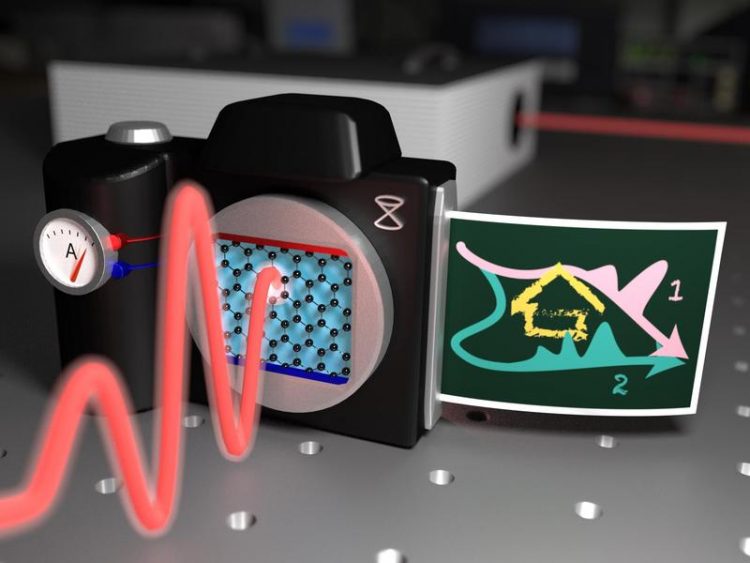The fastest light-driven current source

Schematic of the experiment for ultra-fast current generation: When the light wave (red) hits the graphene (honeycomb grid), an electronic current is generated instantly. Image: FAU / Takuya Higuchi
Graphene is up to the job
In gases, insulating materials and semiconductors, scientists have already shown that it is possible to steer electrons with light waves and thus, in principle, to control current. However, this concept has not yet been applied to metals as light cannot usually penetrate the material to control the electrons inside.
To avoid this effect, physicists in the working groups of Prof. Dr. Peter Hommelhoff and Prof. Dr. Heiko Weber used graphene – a semimetal consisting of only a single layer of carbon atoms. Even though graphene is an excellent conductor, it is thin enough to let some light penetrate the material and move the electrons.
For their experiments, the scientists fired extremely short laser pulses with specially engineered waveforms onto graphene. When these light waves hit the graphene, the electrons inside were hurled in one direction, like a whiplash.
‘Under intense optical fields, a current was generated within a fraction of an optical cycle – a half femtosecond. It was surprising that despite these enormous forces, quantum mechanics still plays a key role,’ explains Dr. Takuya Higuchi from the Chair of Laser Physics, the first author of the publication.
Two paths to the same destination
The researchers discovered that the current generation process in the graphene follows complicated quantum mechanics. The electrons travel from their initial state to the excited state by two paths rather than one – similar to a forked road leading to the same destination. Like a wave, the electrons can split at the fork and flow on both roads simultaneously. Depending on the relative phase between the split electron waves, when they meet again, the current can be very large, or not present at all.
‘This is like a water wave. Imagine a wave breaks against a building wall and flows to the left and the right of the building at the same time. At the end of the building, both parts meet again. If the partial waves meet at their peak, a very large wave results and current flows. If one wave is at its peak, the other at its lowest point, the two cancel one another out, and there is no current,’ explains Prof. Dr. Peter Hommelhoff from the Chair of Laser Physics. ‘We can use the light waves to regulate how the electrons move and how much electricity is generated.’
Will we see electronics controlled by light frequency in the future?
The results are another important step in bringing electronics and optics together. In the future, the method could open a door for realizing ultrafast electronics operating at optical frequencies.
The scientists have published their results, supported by the European Research Council (Consolidator Grant NearFieldAtto) and SFB 953 ‘Synthetic Carbon Allotropes', in the journal Nature: doi: 10.1038/nature23900
Further information:
Dr. Takuya Higuchi
Phone: +49 9131 8528335
takuya.higuchi@fau.de
Prof. Dr. Peter Hommelhoff
Phone: +49 9131 8527090
peter.hommelhoff@fau.de
Prof. Dr. Heiko Weber
Phone: +49 9131 8528421
heiko.weber@fau.de
Media Contact
More Information:
http://www.fau.de/All latest news from the category: Physics and Astronomy
This area deals with the fundamental laws and building blocks of nature and how they interact, the properties and the behavior of matter, and research into space and time and their structures.
innovations-report provides in-depth reports and articles on subjects such as astrophysics, laser technologies, nuclear, quantum, particle and solid-state physics, nanotechnologies, planetary research and findings (Mars, Venus) and developments related to the Hubble Telescope.
Newest articles

Superradiant atoms could push the boundaries of how precisely time can be measured
Superradiant atoms can help us measure time more precisely than ever. In a new study, researchers from the University of Copenhagen present a new method for measuring the time interval,…

Ion thermoelectric conversion devices for near room temperature
The electrode sheet of the thermoelectric device consists of ionic hydrogel, which is sandwiched between the electrodes to form, and the Prussian blue on the electrode undergoes a redox reaction…

Zap Energy achieves 37-million-degree temperatures in a compact device
New publication reports record electron temperatures for a small-scale, sheared-flow-stabilized Z-pinch fusion device. In the nine decades since humans first produced fusion reactions, only a few fusion technologies have demonstrated…





















